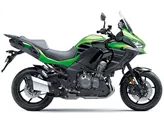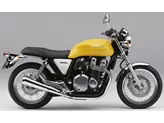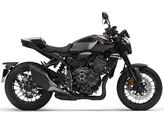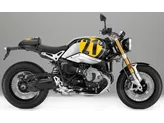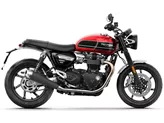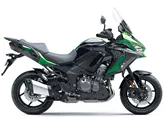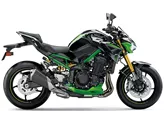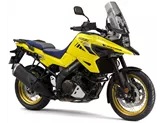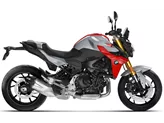Kawasaki Versys 1000 2016 vs. Kawasaki Z900 RS 2018

Kawasaki Versys 1000 2016

Kawasaki Z900 RS 2018
Vue d’ensemble - Kawasaki Versys 1000 2016 vs Kawasaki Z900 RS 2018
The Kawasaki Versys 1000 2016 and the Kawasaki Z900 RS 2018 are both impressive motorcycles with their own unique features and strengths.
Starting with the Kawasaki Versys 1000 2016, it boasts a sporty look and a comfortable seating position, making it suitable for long rides. Its in-line four-cylinder engine delivers a powerful and refined performance, with an engine power of 120 HP and torque of 102 Nm. The transmission is chain-driven, and it has a displacement of 1043 ccm. The suspension system includes an upside-down telescopic fork at the front, with adjustable compression, preload, and rebound settings for a customized riding experience. The rear suspension also offers adjustment options for compression, preload, and rebound. The aluminum frame provides stability and durability, while the double disk brakes with four pistons ensure efficient stopping power. The front and rear tires have a width of 120 mm and 180 mm, respectively, with a diameter of 17 inches. The wheelbase measures 1520 mm, and the seat height is 840 mm. With a kerb weight of 250 kg (with ABS), it is slightly heavier compared to other motorcycles in its class. However, it compensates for this with a generous fuel tank capacity of 21 liters, allowing for longer rides without frequent refueling.

Kawasaki Versys 1000 2016
On the other hand, the Kawasaki Z900 RS 2018 offers a powerful and smooth riding experience. It features a comfortable seating position and easy handling, making it suitable for riders of all skill levels. The in-line four-cylinder engine delivers a strong performance, with an engine power of 111 HP and torque of 98.6 Nm. The transmission is also chain-driven, and it has a displacement of 948 ccm. The front suspension consists of an upside-down telescopic fork with adjustable compression, preload, and rebound settings, while the rear suspension offers adjustment options for preload and rebound. The frame is made of steel, providing strength and stability. The double disk brakes with four pistons ensure reliable braking performance. The front and rear tires have the same dimensions as the Versys 1000, with a width of 120 mm and 180 mm, respectively, and a diameter of 17 inches. The wheelbase is slightly shorter at 1470 mm, and the seat height is 835 mm. With a kerb weight of 215 kg (with ABS), it is lighter compared to the Versys 1000. However, it has a smaller fuel tank capacity of 17 liters, which may require more frequent refueling during long rides.
In terms of weaknesses, the Kawasaki Versys 1000 2016 has a windshield that can only be adjusted when stationary, which may be inconvenient for some riders. Additionally, the gear indicator is not included as a standard feature and requires an additional cost.

Kawasaki Z900 RS 2018
On the other hand, the Kawasaki Z900 RS 2018 does not have a shift assistant, which could be a drawback for riders who prefer this feature. It is also slightly heavier compared to other retro bikes in its class, which may affect maneuverability. The seat is reported to be a little too soft for long tours, and there is no wind protection, which could be a disadvantage for riders who prioritize comfort and protection from the elements.
In conclusion, both the Kawasaki Versys 1000 2016 and the Kawasaki Z900 RS 2018 offer their own unique strengths and weaknesses. The Versys 1000 excels in its sporty look, comfortable seating position, powerful engine, and adjustable windshield, while the Z900 RS stands out with its powerful engine, good looks, comfortable seating position, and balanced handling. Ultimately, the choice between these two motorcycles depends on the rider's preferences and priorities.
Caractéristiques techniques Kawasaki Versys 1000 2016 par rapport à Kawasaki Z900 RS 2018
Avantages et inconvénients en comparaison
Avantages et inconvénients en comparaison
Kawasaki Versys 1000 2016

La Kawasaki Versys 1000 n'est pas un modèle entièrement nouveau - même si son design en donne l'impression. Son look a été très habilement adapté à la ligne agressive actuelle de Kawasaki, avec deux phares pointus et de nombreuses arêtes à l'avant. Sur le plan technique en revanche, elle a été améliorée avec précaution - mais de manière tout à fait judicieuse. Deux chevaux supplémentaires font passer la puissance à 120 ch, qui se laissent parfaitement conduire grâce à la magnifique caractéristique du quatre cylindres en ligne. Le châssis correspond aux exigences sportives d'une Kawasaki, l'ergonomie et la position de conduite confortable permettent néanmoins de voyager loin - comme le prévoit le cahier des charges d'une grande enduro. Avec des accessoires judicieux comme un set de valises, un top-case, des poignées chauffantes et des phares supplémentaires, la Versys 1000 se transforme en une touriste sérieuse sur de longues distances - le prix de base relativement bas rend ces gadgets tout à fait abordables.
Kawasaki Z900 RS 2018

Son quatre cylindres est doux comme de la soie et fournit en même temps suffisamment de puissance pour faire sourire sous le casque. De plus, elle est très facile à déplacer, ce qui devrait en faire un excellent véhicule de banlieue au quotidien et un funbike culte le week-end. L'optique trouve le juste milieu entre le design classique et les détails modernes pour former un ensemble rétro cohérent, qui est en même temps un hommage digne de l'histoire de Kawasaki. C'est une superbe nakedbike à l'allure élégante.
Comparaison des prix Prix moyen du marché Kawasaki Versys 1000 vs Kawasaki Z900 RS
There are a few key differences between a Kawasaki Versys 1000 2016 and a Kawasaki Z900 RS 2018. In terms of price, the actual average price of a Kawasaki Z900 RS 2018 is about 24% higher. A Kawasaki Versys 1000 2016 experiences a loss of 1,080 USD in one year and 930 USD in two years of ownership. This is offset by a loss of 900 USD and 1,070 USD for a Kawasaki Z900 RS 2018. Compared to Kawasaki Z900 RS 2018 there are less Kawasaki Versys 1000 2016 bikes available on the 1000PS.de Marketplace, specifically 7 compared to 28. It takes less time to sell a Kawasaki Versys 1000 with 88 days compared to 154 days for a Kawasaki Z900 RS. Since model year 2012 1000PS.de editors have written 19 reviews for the Kawasaki Versys 1000 and 26 reviews for the Kawasaki Z900 RS since model year 2018. The first review for the Kawasaki Versys 1000 was published on 11/7/2011 and now has more than 8,400 views. This compares to more than 63,700 views for the first review on Kawasaki Z900 RS published on 9/6/2017.



